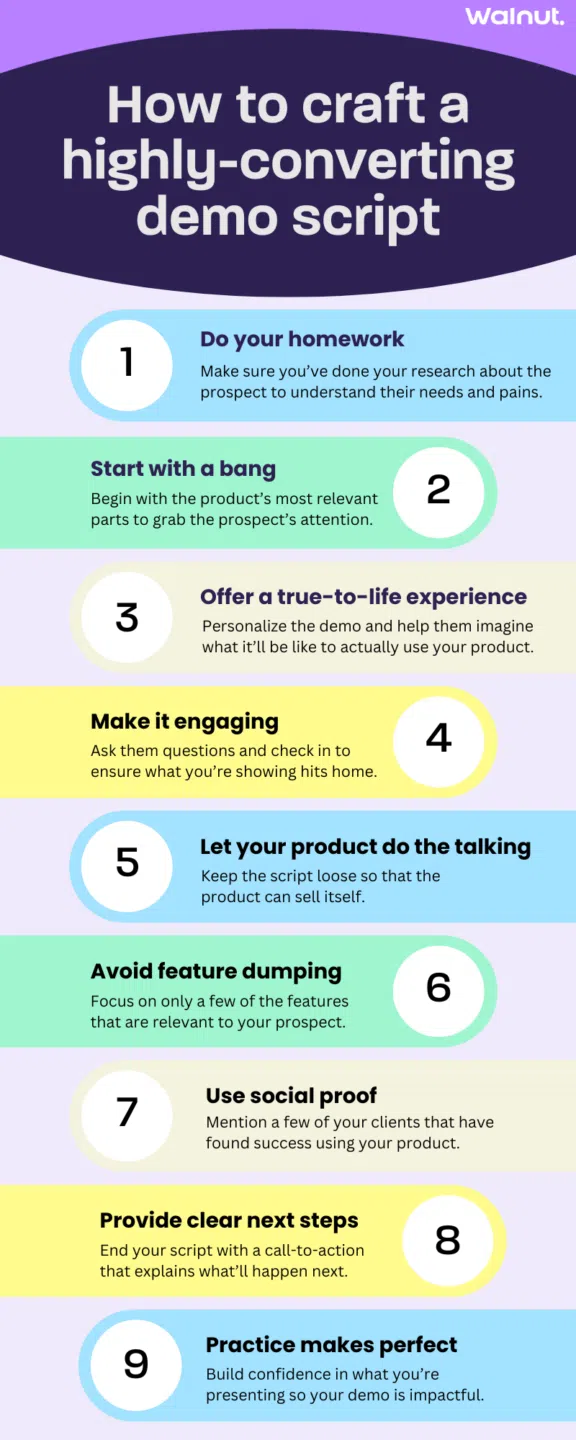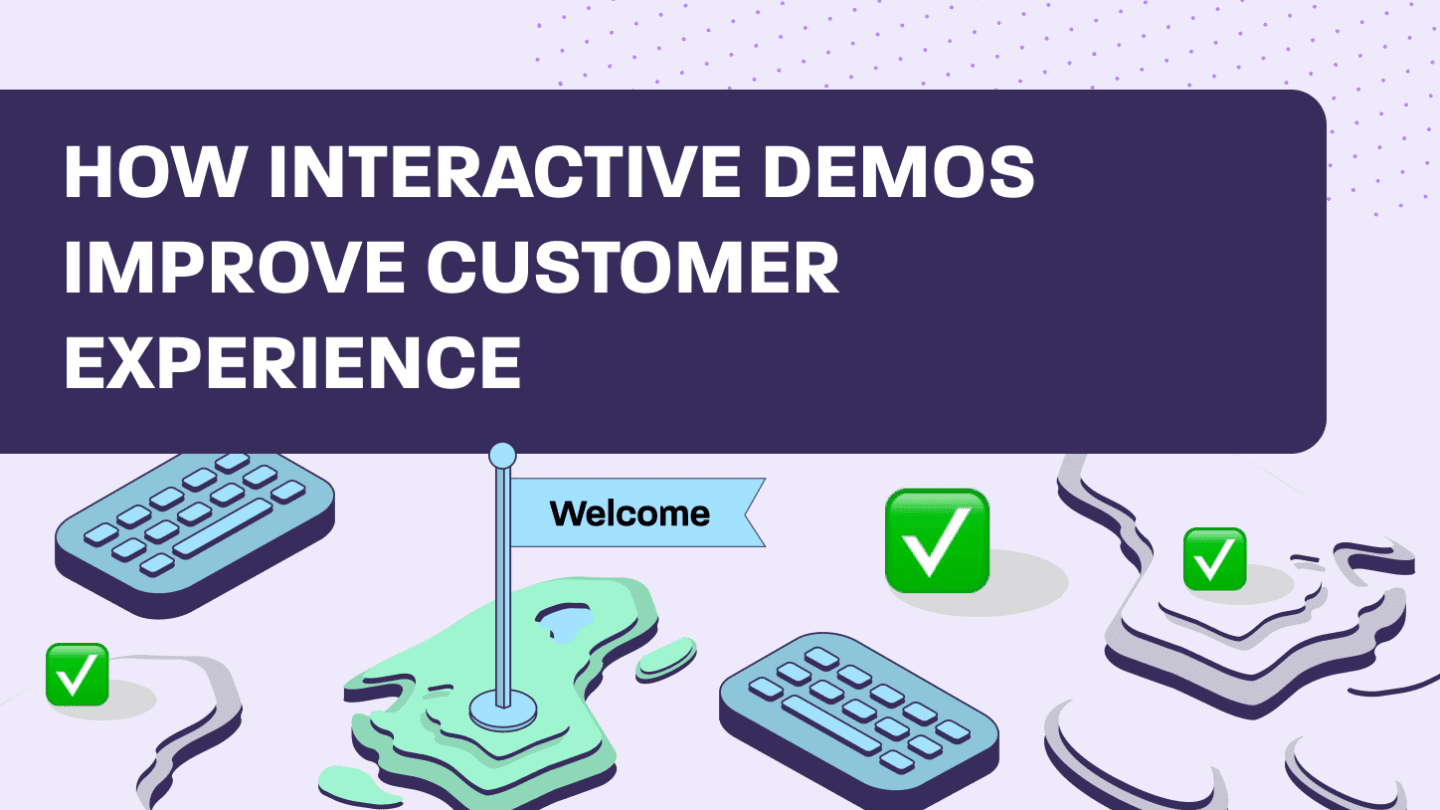Updated November 14, 2023.
The product demo phase is one of the most critical parts of the sales process. If you allow us a cheap comparison, until this time, the relationship with the prospect was like chatting with a partner before a blind-date. You gave your sales pitch, described your company, tried to align expectations, and everything seemed great on paper.
But now it’s time to meet. The prospect will only know if there’s a match once they meet your software. And you don’t want to mess that up – that’s what will make or break the deal.
With this in mind, join us as we break down everything you need to know about planning, creating, and preparing the demo script before the pitch so you can give yourself the best chance for success.
What is a sales demo script?
A demo script is the written portion of your demo that outlines the narrative you’ll use when showcasing your visuals.
Your sales demo script offers a prompt for critical messages, visuals, benefits, and customer pain points you want to cover with your clients during a demo.
Usually, any demo script will include an overview of your product works, its unique value proposition, and how it will tackle the buyer’s needs and pains.
On top of this, part of the demo script will typically focus on handling objections to address common questions or concerns that may come up during the course of the sales demo.
With a well-written demo script, you’ll be able to more effectively showcase why your product will be life-changing for prospects. And this in turn, will make it more likely that the buyer will convert as well as improve the buying experience you offer.
Why demo scripts are critical to your demo’s success
According to a survey from Walnut about B2B SaaS buyers, 97% of buyers say that a bad demo could lead to a lost sale.
And one common demo mistake that can lead to a bad demo is going in unprepared.
Having a demo script will help you make sure:
Messaging remains consistent—Sticking to your prepared script will help you make sure that the narrative remains the same throughout the demo. And this will go a long way in making sure the prospect doesn’t get confused during the demo.
There’s a clear narrative—By using a demo script, you’ll be able to offer clarity on how your product works and why its features will help prospects tackle the challenges they’re facing.
The demo is efficient—Using a structured and thought-out script, you’ll ensure that you get the most out of the limited time you have with the prospect.
The demo experience is personalized—The demo script can be tailored with information about a prospect’s specific needs, interests, and pains to offer a personalized demo experience.
Objections are successfully handled—Like we mentioned earlier, when done right, having a demo script can prepare you for any concerns, objections, or questions that a prospect might have during the demo. This shows that you did your homework and that you are there to help make the buyer feel 100% confident in their purchasing decision.
That’s why it’s essential to get the demo script right. Because when you go into a demo prepared with a well-written script, you increase the likelihood that the buyer will end up converting.
Researching before writing a demo script
Before writing your demo script, you should have already had several interactions with your prospect.
You used your initial discovery call to qualify your potential customer and learn more about their pain points.
Now, you need to supplement the knowledge you gained during this call with additional research into the industry. In other words: Use everything you already know about the client to personalize your script.
But before you grab your pen and paper, there are a few other factors you need to keep in mind before you craft your demo script.
What to keep in mind when drafting your demo script
There are a few questions you need to ask yourself before you sit down and draft your demo script.
1. Is the prospect a fit for your product?
This may seem like a silly question, but it’s one that you must ask.
While you know your product is the greatest thing since sliced bread, there is a chance that it won’t be a match for every single buyer you encounter. And that’s ok.
It’s better to know this than waste both your time and the prospect’s time trying to sell them a product that they don’t need and will probably never buy.
So, we recommend incorporating what you learned from discovery about their industry, needs, and pains, and personalize the demo script to find out if they really are a fit for the product.
2. Can you incorporate social proof?
When it comes to getting prospects to trust your brand and your product, there’s nothing like including social proof.
It shows that other respected companies in similar industries have committed to your product. Additionally, it demonstrates that the product was able to solve their pain points and deliver positive ROI.
That’s why we recommend highlighting a few companies that are a similar size and have similar challenges in your script to show prospects how effective the product was for their peers. This will help them see that it could also be really useful for their own needs.
3. Are you forgetting about the logistics?
It is important to consider all of the logistics of your demo.
First and foremost, you’ll want to pay attention to length. According to Walnut’s product report, the average time prospects spend on demos is just 6.5 minutes.

This means it’s better to keep your demos short and straight to the point.
On top of this, you need to think of ways to ensure the prospect remains hooked from start to finish. You can do this by checking in with the prospect throughout the demo and asking them questions to make sure the parts of the product you’re showcasing are relevant to them.
Lastly, you want to make sure that even after you draft your script, that you’re always going back and tweaking it based on feedback or data that you collect. This’ll ensure that you are always making improvements to your demo.
How to structure your sales demo script step-by-step (with examples)
You should prepare to think on your feet during a demo, but using a predetermined structure will improve the flow of your demonstration and make you appear confident and well-prepared.
Introduce yourself and the main message
The goal of the introduction is to build rapport and credibility with your prospect.
Start by introducing yourself and why you are qualified to present your product to the prospects. If you’ve worked with businesses similar to the prospect’s company, tell them up front so they know you understand their industry and pain points.
Then, reiterate your main message. Think of the one thing you want clients to remember after you’ve left. You may want to repeat this message a few times and close with a reiteration at the end.
Another good tip, that was shared with us Mike DeCorso, VP Sales at THNKS, is to call the prospect by their name, many times during the discussion.
Your main message should answer the question: “How does this solution solve the prospect’s needs/pain points?”
Here’s an example of an introduction and main message highlighted by a sales rep:
“First of all, thank you [name] for agreeing to see me. I know you are pretty busy. I understand from our initial call that you are interested in finding a new way of managing your sales pipeline.
You indicated that it’s time-consuming to manually schedule these tasks and that sales staff often get confused and miss essential details. I’ve seen this happen at Company (XYZ), whom you may know, and we’ve managed to automate their entire pipeline in less than a week.
Today I’m going to show you how to automate all your tasks so you won’t have to set reminders or manage your sales team every day manually. How does that sound to you [name]?”
This structure gives the prospect context of what you are about to show them and how it is relevant. Ending the introduction with a question is a technique used to engage your prospects’ attention.
Tie the features to the pain points
Your SaaS product demo shouldn’t delve into every little feature and detail of your solution. Identify the primary pain points your client has, and tie a product feature to each one.
According to Rachel Shekhtman, VP Sales (Growth) at Namagoo, you should even try to remind your prospect regularly of their own pain while using their own words.
Reveal each capability in layers, according to their level of interest. Show the route to the desired result with the fewest clicks to help the client visualize using the software solution.
Keep their attention by asking relevant questions. Here’s an example:
“During our last conversation, you said that it was difficult for your team to share documentation. Now, this portion of the demo will show you how to upload and share documents and emails right from your Outlook and word processing system. It saves a lot of time and confusion, right?”
You could also lead with a question:
“Do you ever have a scenario where two salespeople reach out to the same lead and then start arguing about whose lead it is? Sure! It happens all the time. Now, here’s how you can avoid that by using our software.”
Once you’ve demonstrated the core functionality of each feature, you can dive deeper and reveal more details according to the prospect’s level of interest.
The AHA moment
The AHA moment is the moment you want customers to remember. Your AHA moment is something you show, not tell.
Press a button and show how your solution can pull immediate insights from big data. Showcase how your software demos can compress huge files or pull up the dashboard that sales staff can access when they sign up. Think of Steve Jobs pulling out the MacBook Air from an envelope for the first time.
Your AHA moment requires showmanship, for example:
“Now we come to the best part of the presentation. If you view this portion of the demo, you’ll see we’ve recreated a series of calendars, documents, and emails. It’s typical of what you would see if you rely on a manual system, right?
Now we hit this button, and you will import everything! You have complete visibility into your entire team and their historical interactions with your clients up to the present date.”
Reinforce the message and close
Don’t assume that your client has absorbed every piece of information you’ve shared. Reiterate your main message once again before you close.
Close with a call to action. Ask the prospect to sign up for the first month, schedule a follow-up meeting, or set up a call to finalize the paperwork.
As an example:
“So we’ve shown you how you can use our product to pull all of the information related to your sales funnel into the cloud. As I’ve mentioned, we integrate with all your existing software so you can log all future and past interactions.
Can you let me know if you want to sign up for August 1st? If so, I’ll send you the relevant paperwork this afternoon.”
How to avoid common demo script mistakes
Not all product demos go as smoothly as planned. A failed demo can eradicate the trust you’ve built up with prospects over weeks and months of nurturing. But there are many more mistakes to avoid during a demo. Below two common ones:
Know where the fault lines are
If your product or software has a few glitches or known problems, prepare in advance. They may or may not come up during the demo, but prepare anyway.
Disable any alarms, notifications, and pop-ups that might disrupt the flow of your demo.
Make it failure-proof
Picture this: you spend the entire demo telling your customers how slick and sophisticated your product is, only to have it fail when you try to showcase it in practice. Nothing causes a loss of momentum like weak Wi-Fi or a live preview that lags painfully.
Tech failures can undermine your entire message. So make sure that your presentations are failure-proof and consistent every single time.
Examples of winning sales demos
Here are some examples of impressive product demos to give you some inspiration and get those creative juices flowing.
(What even are creative juices?)
Contractbook
What do we love about this demo?
Well, for starters, it’s available on the website for anyone to see without needing to first book a call.
On top of this, the demo script is kept short and sweet, with only the most important parts of the product being showcased.
They also give the option to schedule a demo with their team that is personalized to a prospect’s needs.
Zendesk
With Zendesk’s interactive demo, they go through a real-life scenario to help prospects imagine what it would actually be like to use their product.
Not to mention, the script in the demo is kept to 10 slides. By keeping the demo concise, the company is making sure that prospects will remain focused from start to finish and won’t get overwhelmed with too much information.
Checklist for crafting a highly-converting demo script
Before you finalize your demo script, remember not to skip any of these steps to make sure it’ll get the job done and turn your prospects into paying customers.
1. Do your homework—Before you write your script, make sure you’ve done your research about the prospect to understand their unique needs and pains. You can then personalize your demo to show how your product is the solution to the challenges they’re facing.
2. Start with a bang—No need for a grand finale! Start with the most relevant and richest parts of the product to make sure you grab prospects’ attention and keep them interested the whole time.
3. Offer a true-to-life experience—Personalize the demo with the prospect’s branding and use cases or verticals that are relevant to their needs. This will help them imagine what it’ll be like to actually use your product.
4. Make it engaging—Make sure that your demo is interactive and engaging. To keep prospects hooked, ask them questions and periodically check in to make sure what you’re showing is really relevant.
5. Let your product do the talking—Make sure your script allows you to let your product sell itself.
6. Avoid feature dumping—Remember, no prospect wants to sit through a demo where you’re just listing feature after feature. Only focus on a few of your product’s features that are relevant to your prospect and highlight how they can solve their problems.
7. Use social proof—To establish trust, mention a few of your clients that have seen positive results after using your product.
8. Provide clear next steps—Make sure your script ends with a clear call-to-action so that your prospect knows exactly what the next steps will be.
9. Practice makes perfect—Make sure to rehearse your demo script to ensure that you are as confident and comfortable as possible. When you are confident in what you’re presenting, it’ll help make sure your demo is meaningful and impactful.

Using Walnut to perfect your demo script
We know there’s a lot to keep in mind when it comes to crafting a demo script.
But there are tools out there that can simplify the process for you and the rest of your sales team.
(That is, if you’re using Walnut.)
With Walnut, you can use the OpenAI integration to write compelling product stories with ease. As part of the presenter notes, we offer an AI-powered writing assistant named Nutty that can help you edit your current notes, write new scripts, or answer any questions you may have.
This’ll not only save you time when it comes to writing your scripts, but also enrich your overall sales demo.
Get the demo script right, every time
At the end of the day, the main difficulty is to make sure your demos are consistent for all your prospects and across your sales reps.
Providing them with a demo script is a great start, but you should also make sure that the flows of your product presentation are perfect for each customer’s use case. The ultimate goal is to master your demos consistency and quality in order to scale.
Walnut codeless platform not only allows you to create personalized, failure-proof and interactive product demos. It also gives you the ability to create “demo templates” (AKA storylines) for your sales team to ensure your product story is always consistent. And more? You’ll collect valuable insights about your prospect usage to optimize your entire sales process.
Your product demo is your chance to close a deal and showcase your product. Let Walnut help you get it right, every time.
Click “Get Started” to start delivering highly-converting interactive product demos.





